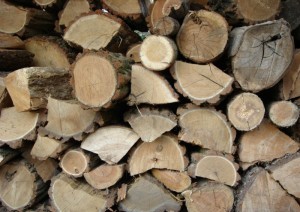by Billy Sweet | Mar 26, 2016 | Seasoned Firewood, wood burning
Where There’s Smoke, There’s Fire
Yes, smoke generally means a fire exists. However, in your fireplace or furnace, smoke usually indicates a less-than-efficient fire. If your fireplace is smoky, you most likely have a problem with your fuel, or with your venting system.

Proper Fuel
It is very important to choose properly seasoned wood to burn in your fireplace or furnace. If your wood is green or wet it will burn slower, less hot, and maybe incompletely. When green or wet wood is burned it often doesn’t burn hot enough to push the smoke up the chimney, causing the smoke to stall, and fall back down.
Improper Use or Maintenance
If your fireplace is releasing excess smoke into your home, you should first check the damper. The damper should be open in order to allow the smoke to rise up the chimney. If the damper lever is opened, the opening may be blocked by soot buildup or debris. Like the damper, if the chimney isn’t routinely cleaned, layers of soot can prevent the smoke from rising up the chimney and out of the home. You can schedule your routine chimney sweeping to have your chimney flue and damper cleaned thoroughly.
Venting Problem
In order for gas to leave the home through the chimney, it has to pull from inside the home. When air is removed from the home it must be replaced. Modern homes are built tight, so air isn’t pulled from outside as the gases attempt to rise up the chimney. Even adding insulation or replacing windows in the home can create a smoke problem for this reason. An easy way to fix this problem is to open a window in another part of the home.
Also, it’s important to note that other home appliances can compete with the ventilation of the chimney. Even something as simple and harmless as a ceiling fan can compete with your chimney. Also, a leaky chimney can disrupt the draft of your fireplace.
Regardless of the cause, no home or business owner wants to deal with a smoke problem in the fireplace or furnace. Not only is it unpleasant, but it can cause respiratory issues if not corrected, and can also be a fire hazard. If the heated gases aren’t moving up the chimney, they can stall in the chimney flue and cause a flue fire. Because your chimney system is important, and the safety of your family and property are our top priority at Billy Sweet Chimney Sweep, we recommend calling a professional if a smoking fireplace persists. Schedule your appointment today.
For more information about why your chimney isn’t working, check out the Chimney Safety Institute of America (CSIA) and “100 Reasons Your Fireplace Doesn’t Work”.
by Billy Sweet | Dec 19, 2014 | Seasoned Firewood
Staying warm this winter requires the proper preparation. For maintaining a comfortable temperature inside the home, this could involve starting a fire in the wood burning stove or fireplace. To ensure the hottest, most fuel efficient fire, you have to start off with the best firewood.

The most critical trait to consider in your firewood is the extent of its seasoning. To be seasoned is to have been allowed to dry fully by being stored indoors for a specific amount of time. Essentially, seasoned wood means dry wood. How long the wood needs to completely season varies based on the type of wood. Softer varieties of wood may season in six month, while hardwoods can require as long as two years to achieve completer dryness.
Preferably, any wood you burn should have been allowed to season completely prior to burning. To follow this guideline, you have two options. First, you can purchase wood that is already fully seasoned. This wood can be burned right away for the best fuel efficiency, but you may have a hard time finding it. If you do find well seasoned wood for sale, it probably costs significantly more than the wet wood. The other option is to purchase wet wood and allow it to season in a shed or garage. This option saves you upfront costs, but it involves planning one or two years in advance. Either option you choose, you should always burn seasoned wood. A lot of energy is wasted on wet wood by boiling away the trapped moisture, so you end up with a colder fire, excess smoke, more spent on fuel, and incompletely burnt wood.
Incompletely burnt wood creates health risks because it produces a black, tarry material called creosote. Initially a vapor as it exits the fire, creosote condenses inside the chimney. Over time the creosote can build up and restrict the air flow through the chimney, which can lead to poor indoor air quality. The high flammability of creosote can also result in a chimney fire from a mere stray ember. Luckily, avoiding this risk is as easy as burning seasoned wood and having an annual chimney sweep and inspection done.
Just because you purchase seasoned wood does not mean it stays seasoned forever. How you store the wood after you buy it and before you burn it determines whether or not it remains fully seasoned. The ideal storage arrangement involves stacking the wood, with a depth of only one log, in a shed or other outdoor building. Leave the wood uncovered to prevent condensation. If the wood must sit outside, protect it from the elements by creating a sturdy roof for it. A piece of sheet metal works well. Be sure to leave the sides of the stack uncovered to encourage air flow.
If you have any questions about firewood or if you need to schedule a chimney sweep or inspection, contact Billy Sweet Chimney Sweep to speak with an expert.


